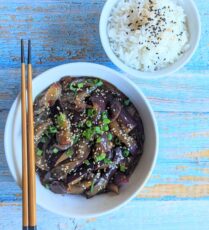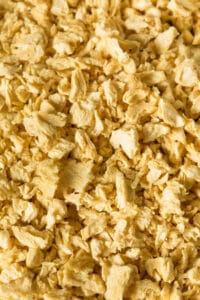Back in the late eighties after becoming vegetarian, we quickly discovered many wonderful uses for tofu. We were mostly using plain firm and extra firm tofu that had to be seasoned and transformed into delicious dishes. Some of our favorites were and still are scrambled tofu for a high protein breakfast, marinated, pan-fried, cubed into stir fry you get the idea. Tofu, also known as bean curd is basically a sponge that awaits to be flavored and become delicious protein flavored for whatever you are in the mood for!
It was only after hanging and dining out with Taiwanese and Vietnamese friends that were amazing cooks that we discovered a whole new world of soybean products that we had no idea existed. You are in for a treat! Who said tofu was boring? Some of these products can be bought in most grocery stores, others are only available in Asian stores but they are totally worth the trip and the adventure!
So get ready to venture out of your comfort zone and try new creations. This list is by no means complete but it will hopefully open new culinary horizons for you as it did for us.
 1. Firm & Extra firm Tofu
1. Firm & Extra firm Tofu
No surprise here! We are starting with the basics. It is only after experimenting a lot that we discovered the subtle differences between firm and extra firm tofu and can now use it to your advantage.
Firm tofu is the most popular and most available type. Always buy organic because most of the soy that is grown in the US is grown to feed farm animals!
Available in: the refrigerated section of most grocery stores.
Comes in: plastic container with little water.
Store in a plastic or glass container with a lid and make sure to include some water to preserve it.
Tastes like: a plain sponge that awaits to be flavored!
Best used in vegetable noodle bowls, scrambles, marinades, shish kebab or brochettes (after pressing it) etc.
Extra-firm tofu
Extra-firm tofu has been pressed so that most of the water has been removed. As a result, the tofu is dry, has a firmer texture. It will hold its shape (whether it is cubed, sliced, or cut into sticks) through the cooking process, whether you stir fry it, bake it or roast it. It will crumble when you try to mash it and resembles feta cheese.
Available in: the refrigerated section of most grocery stores.
Comes in: plastic container with little water. Make sure to refill it if you don’t use it all.
Best used for: tofu fries, brochettes, stews like saag paneer, strips, etc.
Not recommended for: smoothies, deserts, making creams as it will create a grainy result.
2. Soft/silken tofu
This is a completely different type of tofu. It is quite delicate and has a lovely silky texture.
Available in: plain and flavored (mango, strawberry, etc.) in the refrigerated section next to the regular tofu. Flavored versions are ready to eat. If you buy the plain version, just pour some maple syrup over a few cubes for a quick sweet treat!
How it is made: This is the less pressed of all tofu so the curds & the whey are well blended.
Tastes like: Silky plain pudding.
Best used: cubed in soups like miso, to add thickness to soups, to make silky puddings, smoothies, custards, and other desserts.
It can also be eaten raw with a soy marinade and chopped green onions.
3. Frozen tofu
This is not a product you can buy but a technique to transform tofu.
Why freeze tofu, you may ask?
Because it radically alters the texture of tofu and makes it more granular. It dries it and makes it even more porous.
The process: The key thing is to press it well before freezing it, let it thaw, press it again and it is ready to absorb all the flavors. These extra steps are totally worth it if you want to create aged vegan ricotta to add to a baked dish like lasagna or make feta cheese for a salad. It is wonderful for Mexican dishes too (think cotija cheese).
4. Deep-fried tofu
This is a light, super crispy, slightly hollow tofu that floats in soups, makes the best tofu fries, and can be stuffed with mushrooms or other vegetables. Deep-fried tofu cubes are delicate, a little squishy. So different from regular tofu, it is barely recognizable.
Where to find it: Asian stores in the refrigerated section.
Refrigerate: You should eat it within a day or two after buying it because it doesn’t contain any preservatives. No worry, you can also freeze it. Once you try it you won’t believe how good it is and how different it is from regular spongy tofu!
5. Inari
Inari is a popular sushi dish, made with thin tofu pouches marinated in a light sweet soy sauce and filled with sushi rice.
Where to find it: in the Asian section of most grocery stores.
The pouches come tightly packed in a small can.
Uses: you can replace sushi rice with vegetable fried rice. The pouches can hold salad mixes… making great little appetizers. You can also fill the pouches with tofu and put in udon or soba soups.
6. TVP (Textured vegetable protein)
What is it made with? Defatted soy flour that has been cooked, dehydrated and made into different size food.
It is quite versatile because it comes in many forms like flakes, small granules, chunks, and slices.
Where to buy: TVP in flakes can be found in the flour section of most grocery stores. Sometimes in the bulk section. TVP in chunks or slices can mostly be found in Asian and Indian stores. So when you go buy a bunch!
Is it good for you? It is high in fiber, low fat, high protein, is a good source of iron.
Textured vegetable protein is a wonderful filler or extender.
How to prepare: It needs to be rehydrated (don’t try eating it dry) 2 cups of water for 1 cup of TVP. Let it soak it for 5-10 minutes. 1 dry cup will yield 2 ¼ cup of rehydrated tvp. You will need to season it too because like tofu it is a blank canvas for you to play with.
Best used: to quickly add protein to a soup, stir fry, vegan meatballs, sloppy Joes, patties, etc.
7. Soy curls (sorry no photo!)
These little dehydrated strips are another version of soy protein meat. They are made the same way but in the form of thin strips. They also must be rehydrated and seasoned. They do not contain any preservatives so you should refrigerate them after opening the package. They will last a long time when refrigerated. They are great for traveling, camping, They take little space but can feed an army!
We use them as a quick replacement for a plant-based protein that can be shredded like in soft tacos, quesadillas, bowls, etc.
8. Yuba bean curd sheets
What it is: This type of bean curd is a by-product of making soy milk. It is the fat layer that floats to the surface that has been dehydrated. It is a very thin sheet
Buy: only in Asian grocery stores and in tofu shops.
Types:
– Fresh sheets in the freezer section
– Dried sheets (very brittle, needs to be rehydrated)
Best used: pan-fried in small delicate patties, stuffed, added to soups. There are so many fun ways to use yuba.
 9. Fermented Tofu
9. Fermented Tofu
Also called, preserved tofu, bean curd cheese, soy cheese, or tofu cheese, this tofu, as the name indicates, has been aged and fermented. This is what gives it its distinctive tang and incredible umami flavor. Fermented tofu is not meant to be eaten as is. It is used in Chinese cooking as a condiment for sauces, soups, stir-fries, marinades that can replace salt. It can be used to kickstart fermentation for homemade cheese, pickles, etc.
This type of tofu is a bit of an acquired taste because of its strong flavor. Remember that a little goes a long way!
Fermented tofu come usually in a small glass jar, and the cheese cubes are in a salty brine.
Is it good for you? Any fermented food will improve our intestinal flora (A.k.a. our microbiome) and by extension, our digestion and ability to absorb more nutrition from the food we are eating by adding probiotics which in turn helps our immune system.
Nutritionally speaking, fermented tofu has a higher protein content than regular tofu. It is rich in calcium, magnesium, iron, potassium, and zinc. Not bad!
Long shelf-life: once opened, a can will last up to 6 months in the fridge.
10. Natto
Here is another type of fermented bean curd product. This one comes from Japan. In this case, whole soybeans that have been soaked, steamed or boiled then inoculated with the bacteria Bacillus subtilis and left to ferment. Natto is rich in K1 which is known to naturally thin the blood.
Where to buy natto: Even though natto is a specialty product mostly used in Japanese cuisine and by people with digestive problems, you can find it at Asian grocery stores, surprisingly at Walmart, at most health stores, and always online.
Caution: A few brands are not vegan and contain fish so be sure to check the ingredients just to be on the safe side.
Best used: with rice, added to stirfry, salad dressing, it can also be spread like vegemite on toast… It is all good!
So there you go, 10 types of bean curd products that will bring variety, fun new textures, and flavors to your cooking. Have fun and drop a note in the comment section if you have any questions!



























